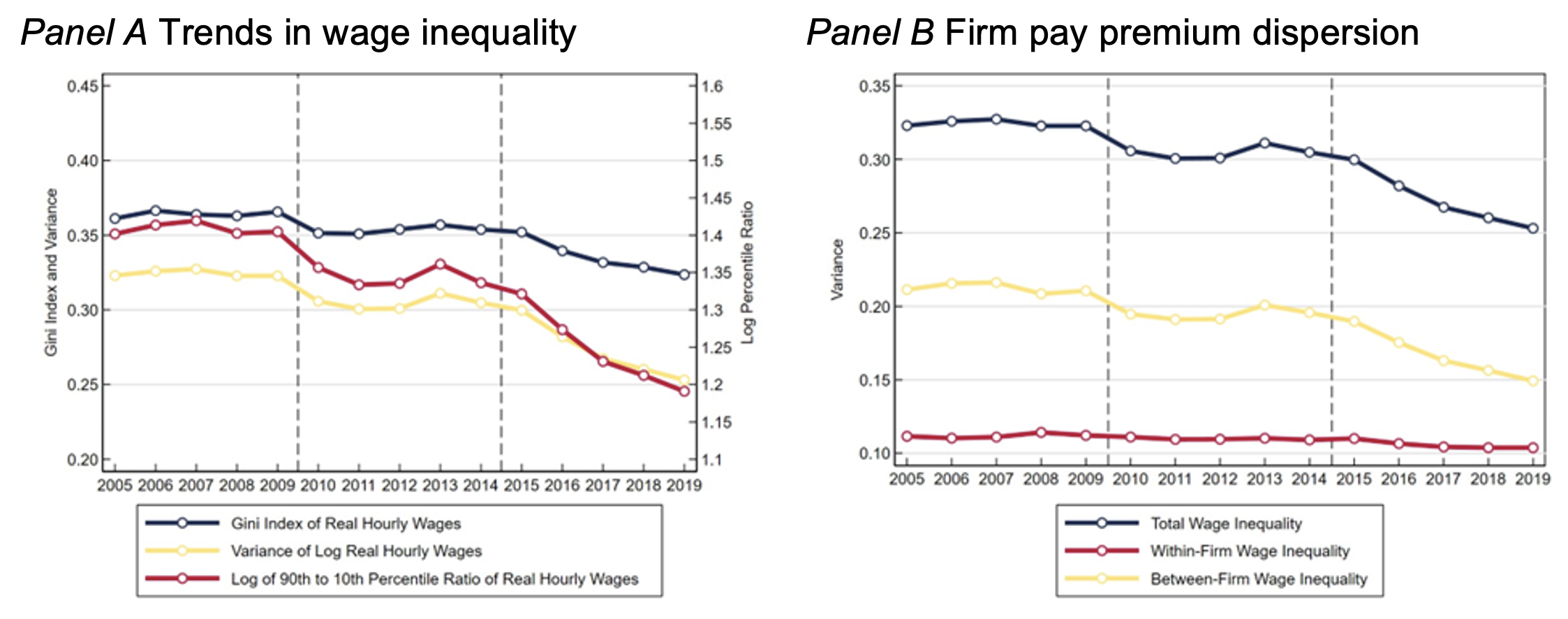Wage inequality has taken centre stage in the policy debate in developed and developing countries (Filauro et al. 2021). Significant resources and a tremendous amount of effort have been devoted to fighting rising inequality. Despite the relevance of firm characteristics for wage inequality (Card et al. 2013, Alvarez et al. 2018, Bloom et al. 2018, Song et al. 2019, Haltiwanger et al. 2022), policies focusing on firms are scarce. Behind this phenomenon lies a lack of understanding of why and how firms matter for wage inequality dynamics.
In a new paper (Leitao et al. 2022), we study the role of firm characteristics in wage inequality dynamics. Which characteristics matter and what is the mechanism whereby these characteristics impact the dynamics of wage dispersion? Answering these questions is critical to help better calibrate inequality-mitigating policies, and ultimately contribute to more efficient allocation of resources.
To this end, we explore rich Portuguese administrative and survey data following workers and their employing firms over time, coupled with unique inequality dynamics observed in Portugal. Portugal witnessed a staggering decline of wage inequality over the course of the last century of about 20% (this is shown in Figure 1 Panel A, using a variety of commonly used metrics). Together with the AKM framework of Abowd et al. (1999) and the variance decomposition of Alvarez et al. (2018) and Messina and Silva (2021), these data and these dynamics allow us to disentangle the contributions of firms, workers, and job-titles to earnings’ dispersion dynamics. This decomposition reveals that firm pay premium dispersion is the main driver of the decline in Portuguese wage inequality. This phenomenon can be seen in Figure 1, Panel B. This figure shows how the dynamics of dispersion in average firm pay policies (the yellow schedule) is closely tracking the evolution of overall wage dispersion (the blue schedule).
Figure 1 Dynamics of Portuguese wage inequality
Which firm characteristics matter for wage dispersion?
Following the literature, firm-induced changes in wage inequality can be driven by three main factors: market structure (Bao et al. 2022), firm size, and productivity. Using a recentred influence function (RIF) (Firpo et al. 2009, 2018), we estimate the contribution of changes in each of these characteristics to changes in the dispersion of firm pay premiums. Skill intensity within the firm, followed by firm labour productivity, are the primary drivers behind the decline of firm pay premium dispersion. An increasing share of workers earning the minimum wage and a reduction in labour market concentration also contributed to the fall in between- firm pay premium dispersion but had smaller roles.
What is the underlying mechanism for wage convergence across similarly skilled workers working at different firms?
Are firms becoming more similar or is that the extent to which a given characteristic (such as working at a more productive or skill-intensive firm) translates into a higher pay is declining? Using an Oaxaca-Blinder (Oaxaca 1973, Blinder 1973, Kitagawa 1955) decomposition and applying it to RIF regressions, we find that inequality fell in Portugal, almost exclusively because of the disappearing of the wage premium associated with ‘good-firm’ characteristics. Figure 2 illustrates this phenomenon graphically. The change in firm pay premium dispersion is explained primarily by a decline in the return to each firm characteristic (‘passthrough effect’). The most significant contributions come from firm’s skill composition, productivity, and the share of workers earning the minimum wage. The observed decrease in firm pay premium dispersion translates into a decline in wage inequality.
Figure 2 Distributional and returns effects to firm characteristics
Different firms compensate the same type of workers differently. Such firm differentials between more and less productive firms and between more or less technologically intense firms, are smaller today than they were 20 years ago in Portugal. What does this mean? Take the relative difference between the wages of two similar managers (same age, gender, and education) working in a high versus low productivity firm. This difference fell over time. Their wages became more similar due to the decline of the more productive-firm wage premium. Had the return to these characteristics not declined, the firm driven dispersion of wages would have increased by 8.2%, which would have contributed to a 1.5% increase in wage inequality. Lower passthrough from firm characteristics to pay played a key role in compressing firm pay premiums. The decrease in the passthrough of value added per worker and firm knowledge composition, taken together, explains the largest share of the decrease in the variance of the firm fixed effects.
Within-firm inequality and big data adoption
The role of firms in the evolution of wage inequality is determined by changes in between (wage differentials across similar workers in different firms) and within-firm wage inequality (wage differentials across similar workers in different departments of the same firm). The latter is determined by a variety of factors, such as technological shocks. We draw our attention to a particular one: the effect of big data adoption by Portuguese firms.
Using the IUTICE survey, a unique survey on the diffusion and adoption of technology, distributed to a sample of firms in Portugal, we provide a causal estimate for the effect of big data adoption on within-firm wage dispersion. Our within-firm analysis shows that firms’ adoption of technology, in the form of big data, increases within-firm inequality by as much as 37% of the median of within-firm inequality. This result sides with empirical evidence showing that automation may exact a toll on inequality through skill-biased adoption or wage declines for workers specialised in routine tasks in sectors witnessing steep automation (Acemoglu and Restrepo 2019, Eeckhout et al. 2021). Taken together, our results indicate that firms’ characteristics reduced overall wage inequality in Portugal, even if they might have increased within firm inequality.
Policy takeaways
Our findings suggest that understanding firms’ incentives and promoting policies that affect product market concentration and/or foster productivity and technology adoption for low-technology firms will be key for shaping inequality. These policies constitute an important complement to worker-side polices focused on education, worker mobility, and access to services.
Authors’ note: Any opinions and conclusions expressed in this column are those of the authors and do not necessarily reflect those of their institutions.
References
Abowd, J M, F Kramarz and D N Margolis (1999), “High wage workers and high wage firms”, Econometrica 67(2): 251–333.
Acemoglu, D and P Restrepo (2019), “Automation and new tasks: how technology displaces and reinstates labor”, Journal of Economic Perspectives 33(2): 3–30.
Alvarez, J, F Benguria, N Engbom and C Moser (2018), “Firms and the Decline in Earnings Inequality in Brazil”, American Economic Journal: Macroeconomics 10(1): 149–189.
Bao, R, J De Loecker and J Eeckhout (2022), “Manager pay in the digital age: Size matters, and so does monopoly”, VoxEU.org, 17 May.
Blinder, A S (1973), “Wage Discrimination: Reduced Form and Structural Estimates”, The Journal of Human Resources 8(4):436–455.
Bloom, N, F Guvenen, B S Smith, J Song and T von Wachter (2018), “The Disappearing Large-Firm Wage Premium”, AEA Papers and Proceedings 108: 317–322.
Card, D, J Heining and P Kline (2013), “Workplace heterogeneity and the rise of West German wage inequality”, The Quarterly Journal of Economics 128(3): 967–1015.
Eeckhout, J, C Hedtrich and R Pinheiro (2021), “Inequality is an urban affair, and it’s due to new tech”, VoxEU.org, 16 October.
Filauro, S and G Fischer (2021), “Income inequality in the EU: General trends and policy implications”, VoxEU.org, 17 April.
Firpo, S, N M Fortin and T Lemieux (2009), “Unconditional Quantile Regressions”, Econometrica 77(3): 953–973.
Firpo, S P, N M Fortin and T Lemieux (2018), “Decomposing Wage Distributions Using Recentered Influence Function Regressions”, Econometrics 6(2):28.
Haltiwanger, J, H Hyatt and J Spletzer (2022), “Rising inequality: Industries and mega firms”, VoxEU.org, 30 May.
Kitagawa, E M (1955), “Components of a Difference Between Two Rates”, Journal of the American Statistical Association 50(272): 1168–1194.
Leitao, M, J Montana and J Silva (2022), “The Role of Firms in Wage Inequality Dynamics”, CEPR Discussion Paper 17327.
Messina, J and J Silva (2021), “Twenty Years of Wage Inequality in Latin America”, The World Bank Economic Review 35(1): 117–147.
Oaxaca, R (1973), “Male-female wage differentials in urban labor markets”, International Economic Review 14(3): 693–709.
Song, J, D J Price, F Guvenen, N Bloom and T Von Wachter (2019), “Firming up inequality”, The Quarterly Journal of Economics 134(1): 1–50.








